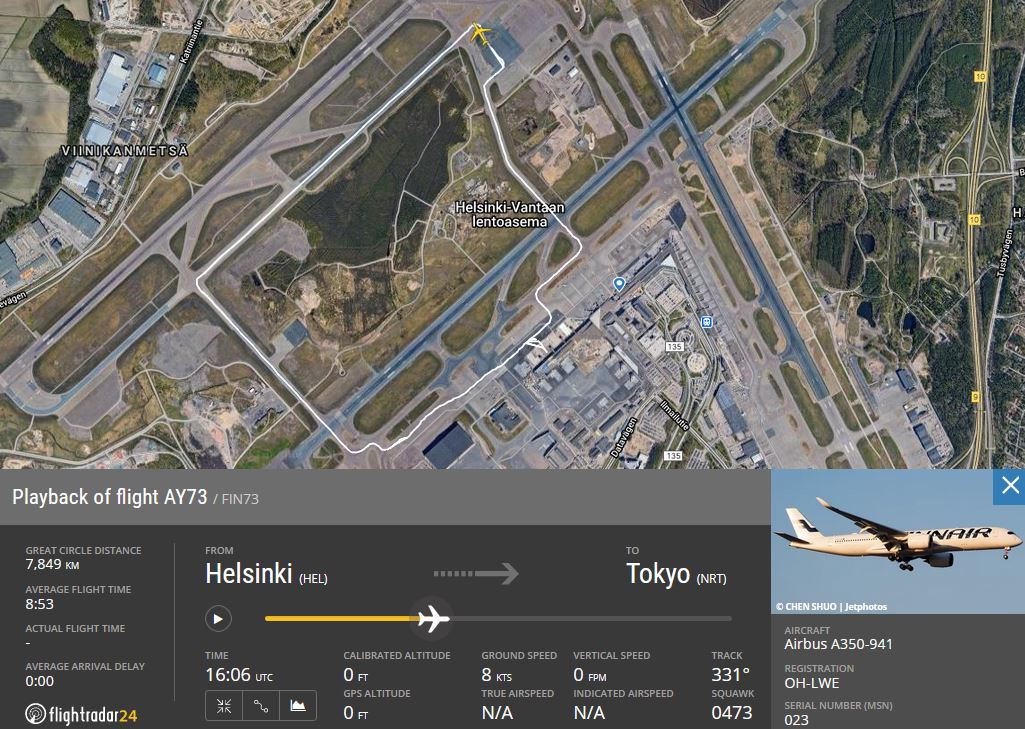
ASN Wikibase Occurrence # 248135
This information is added by users of ASN. Neither ASN nor the Flight Safety Foundation are responsible for the completeness or correctness of this information.
If you feel this information is incomplete or incorrect, you can submit corrected information.
| Date: | Sunday 21 February 2021 |
| Time: | 18:07 LT |
| Type: |  Airbus A350-941 |
| Owner/operator: | Finnair |
| Registration: | OH-LWE |
| MSN: | 023 |
| Engine model: | Rolls-Royce Trent XWB-84 |
| Fatalities: | Fatalities: 0 / Occupants: 3 |
| Aircraft damage: | Minor |
| Category: | Serious incident |
| Location: | Helsinki-Vantaa Airport (HEL/EFHK) -
 Finland Finland
|
| Phase: | Taxi |
| Nature: | Cargo |
| Departure airport: | Helsinki-Vantaa Airport (HEL/EFHK) |
| Tokyo-Narita Airport (NRT/RJAA) | |
| Investigating agency: | SIAF |
| Confidence Rating: |
A Finnair Airbus A350 departing on a cargo flight to Tokyo slid partially off a slippery taxiway at Helsinki-Vantaa Airport, Finland. The aircraft's no.1 engine knocked over a taxiway sign, causing superficial damage to the engine intake lip.
A factor in the incident was the cutting of airport winter maintenance staff by around fifty percent in late 2020 due to Covid 19 pandemic and decline in traffic, which affected ice control and led to non-compliances. Even during periods of major changes, such as those caused by the pandemic, an airport operator must ensure the safety of aircraft operations in the movement area or close portions of the movement area if necessary. Operational safety under difficult weather conditions must not be delegated exclusively to aircraft crews.
The airport operator had carried out a major organizational change to counter the impact of the pandemic. The management and assessment of this change had rested almost entirely with the operator. The operator had not initiated adequate actions in order to manage the risks it had identified, and its reactions to observed non-compliances had been inadequate. Any major change in an operational environment also brings to the fore the role of oversight executed by the aviation authority, which should proactively address any issues noted in operators’ risk management.
Different maintenance requirements and practices were in effect for the aprons, taxiways, and runways, and the method for reporting taxiway friction and condition was less accurate than the runway condition reporting method in use at the time of the incident. Even though aircraft speeds on taxiways and aprons are low, accidents can happen under difficult weather conditions, and the usability criteria of these portions of the movement area should therefore be reassessed.
Airport maintenance had set a high threshold on limiting aircraft operations on the primary movement areas, where sufficient maintenance could have been guaranteed. There were no clear guidelines for the closure of portions of the movement area under extreme weather conditions or in other contingencies. A sophisticated safety management system shall prescribe procedures for the management of abnormal and challenging situations.
Aviation stakeholders have had difficulties in recognizing the fact that loss of aircraft control in the movement area is a serious incident. This has led to failures to initiate prescribed procedures, to application of non-standard practices, and to failures to ensure adequate communication. Published procedures should help operators to recognize the real nature of incidents and provide guidance for situations where the classification of an incident is changed.
Because the seriousness of the incident was not understood initially, the aircraft’s flight recorders were not secured appropriately after the event, and no instructions for securing the cockpit voice recorder were available to the crew members. Securing of the voice recorder is essential for determining the causes of an event and for implementing subsequent safety actions.
Accident investigation:
 |
|
Sources:
http://www.lentoposti.fi/uutiset/finnairin_airbus_a350_900_t_rm_si_rullaustieopasteeseen_helsinki_vantaan_lentoasemalla
https://www.flightradar24.com/data/flights/ay73#26e11305
https://www.lentoposti.fi/uutiset/puutteellinen_liikennealueen_kunnossapito_johti_finnairin_a350_koneen_luisumiseen_ulos_rullaustielt
https://www.turvallisuustutkinta.fi/en/index/tutkintaselostukset/ilmailuonnettomuuksientutkinta/tutkintaselostuksetvuosittain/2021investigations/l2021-02lossofcontrolofairfreighterduringtaxiingathelsinki-vantaaairporton21february2021.html
Images:

Revision history:
| Date/time | Contributor | Updates |
|---|---|---|
| 22-Feb-2021 19:01 | penu | Added |
| 22-Feb-2021 19:08 | harro | Updated [Time, Aircraft type, Registration, Cn, Source, Photo] |
| 10-Nov-2021 14:41 | Dolly564 | Updated [Source] |
| 10-Nov-2021 14:44 | harro | Updated [Time, Nature, Narrative, Accident report] |
| 10-Nov-2021 14:56 | harro | Updated [Total occupants] |
| 10-Nov-2021 20:35 | harro | Updated [Narrative] |
Corrections or additions? ... Edit this accident description
The Aviation Safety Network is an exclusive service provided by:


 ©2024 Flight Safety Foundation
©2024 Flight Safety Foundation